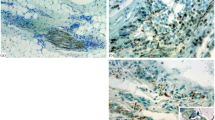Summary
In 26 rats (13 ♂♂ and 13 ♀♀) there has been determined the number of the glomeruli in half a kidney by means of a histological method; in the other half of the kidney the number of the glomeruli was determined by means of a magnetical method.
The accounts, for every method separated, were highly correlated to the relation number of the glomeruli—kidney weight in the histological method (r=0.947 to 0.967).
There was no correlation to be seen in the accounts of the magnetical method (r=−0.058 to +0.412). The arithmetical differences of the number of the glomeruli in both methods had a deviation of +10% to −62%. By reason of these results the magnetical method cannot be regarded as a reliable method in quantitative investigations.
Zusammenfassung
Bei 26 Ratten (13 ♂♂ und 13 ♀♀) wurde von jeweils einer Nierenhälfte mit einer histologischen Serienschnittmethode die Anzahl der Glomerula bestimmt; von der anderen Nierenhälfte erfolgte die Bestimmung der Glomerulumzahl mit Hilfe einer magnetischen Methode.
Die getrennte Auswertung ergab für die histologische Methode eine hochgesicherte Korrelation für die Beziehung Glomerulumzahl—Nierengewicht (r=0,967).
Die Auswertung der Magnetmethode ergab mit r=−0,058 bis +0,412 keine Korrelation. Die arthmetischen Unterschiede der mit beiden Methoden ermittelten Glomerulumzahlen hatten eine Schwankungsbreite von +10% bis −62%.
Aufgrund dieser Untersuchungen kann die Magnetmethode nicht als zuverlässige Methode für quantitative Untersuchungen angesehen werden.
Similar content being viewed by others
Literatur
Arataki, M.: On the postnatal growth of the kidney, with special reference to the number and size of the glomeruli. Amer. J. Anat. 36, 399–436 (1925).
—: Experimental researches on the compensatory enlargement of the surviving kidney after hydronephrosis. Amer. J. Anat. 38, 71–88 (1926).
Bachmann, R., Bölke, U.: Die mit Perjodsäure-Leukofuchsin darstellbaren Strukturen der Niere von Meerschweinchen und Kaninchen. Z. Zellforsch. 42, 423–438 (1955).
Cook, W. F., Pickering, G. W.: A rapid method for separating glomeruli from rabbit kidney. Nature (Lond.) 182, 1103–1104 (1958).
——: The lokation of renin in the rabbit kidney. J. Physiol. (Lond.) 149, 526–536 (1959).
Elias, H., Hennig, A.: Stereology of the human renal glomerulus. Quantitative methods in morphology. Berlin-Heidelberg-New York: Springer 1967.
——, Elias, P. M.: Contributions to the geometry of sectionning. V. Some methods for the study of kidney structure. Z. wiss. Mikr. 65, 70–82 (1961).
Hennig, A.: Fehlerbetrachtungen zur Volumenbestimmung aus der Integration ebener Schnitte. Quantitative methods in morphology. Berlin-Heidelberg-New York: Springer 1967.
Imbrie, J.: Biometrical methods in the study of invertebral fossils. Bull. Amer. Mus. Nat. History. (New York) 108, 223–242 (1956).
Kermack, K. A.: A biometrical study of micraster coranguinum and micraster senenensis. Phil. Trans. B 237, 375–428 (1954).
—, Haldane, J. B. S.: Organic correlation and allometrie. Biometrika 37, 30–40 (1950).
Koller, S.: Graphische Tafeln zur Beurteilung statistischer Zahlen. Darmstadt: Steinkopff 1953.
Runzheimer, J.: Quantitative Untersuchungen an der 5. Gefangenschaftsgeneration von Clethrionomys glareolus. Z. Säugetierk. 34, 9–37 (1969).
Rytand, D. A.: The number and size of mammalian glomeruli as related to kidney and to bodyweight, with methods for their enumeration and measurement. Amer. J. Anat. 62, 501–520 (1938).
Schmeer, K.: Die Berechnung der Nierenkörperchenzahl beim Hunde. Anat. Anz. 89, 353–364 (1940).
Strassberg, J., Paule, J., Gonick, H. C., Maxwell, M. H., Kleeman, C. R.: The quantitative estimation of perfusible glomeruli and the collagen and non-collagen nitrogen of the normal kidney. Nephron (Los Angeles) 4, 384–393 (1967).
Vimtrup, B. J.: On the number, shape, structure and surface area of the glomeruli in the kidney of man and mammals. Amer. J. Anat. 41, 123–151 (1928).
Zehner, I.: Über den Einfluß veränderter Umwelt auf das Herzgewicht der Albinomaus. Zool Anz. 178, 1–18 (1967).
Zolnai, B.: Bemerkungen zur anatomischne Injektions-Korrosionstechnik. II. Glomerulizählung. Versuch zur quantitativen Wertung von mittels Polyvinylchlorid (PVC) angefertigten Nierenkorrosionspräparaten. Anat. Anz. 112, 42–53 (1963).
Author information
Authors and Affiliations
Additional information
Anregung des Themas und Leitung der Arbeit: Prof. Dr. H. Frick.
Rights and permissions
About this article
Cite this article
Seibel, C. Quantitative Erfassung der Glomerula der Rattenniere an histologischen Serienschnitten und mit Hilfe der magnetischen Trennung. Z. Anat. Entwickl. Gesch. 132, 58–74 (1970). https://doi.org/10.1007/BF00520953
Received:
Issue Date:
DOI: https://doi.org/10.1007/BF00520953




